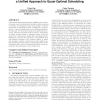Free Online Productivity Tools
i2Speak
i2Symbol
i2OCR
iTex2Img
iWeb2Print
iWeb2Shot
i2Type
iPdf2Split
iPdf2Merge
i2Bopomofo
i2Arabic
i2Style
i2Image
i2PDF
iLatex2Rtf
Sci2ools
EDBT
2008
ACM
2008
ACM
Minimizing latency and memory in DSMS: a unified approach to quasi-optimal scheduling
Data Stream Management Systems (DSMSs) must support optimized execution scheduling of multiple continuous queries on massive, and frequently bursty, data streams. Previous approaches on optimizing memory consumption or response time (i.e., latency) usually produce very different algorithms. In this paper, we extend the popular chart-partitioning procedure, which was previously used for memory optimization on simple operator paths, to minimize latency as well as memory on complex query-graphs with tuple-sharing forks. Furthermore, we test the performance of algorithms that only assume knowledge of the average behavior of tuples and operators, against a theoretical one that assumes detailed knowledge on the behavior of individual tuples. These experiments show that the practical algorithms closely approximate the performance of the optimal ones. Categories and Subject Descriptors H.2.4 [Database Management]: Systems--Query processing; F.2.2 [Analysis of Algorithms and Problem Complexity...
Data Stream Management | Database | EDBT 2008 | General Terms Algorithms | Nonnumerical Algorithms |
| Added | 08 Dec 2009 |
| Updated | 08 Dec 2009 |
| Type | Conference |
| Year | 2008 |
| Where | EDBT |
| Authors | Yijian Bai, Carlo Zaniolo |
Comments (0)

